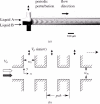Microfluidic mixing: a review
- PMID: 21686184
- PMCID: PMC3116190
- DOI: 10.3390/ijms12053263
Microfluidic mixing: a review
Abstract
The aim of microfluidic mixing is to achieve a thorough and rapid mixing of multiple samples in microscale devices. In such devices, sample mixing is essentially achieved by enhancing the diffusion effect between the different species flows. Broadly speaking, microfluidic mixing schemes can be categorized as either "active", where an external energy force is applied to perturb the sample species, or "passive", where the contact area and contact time of the species samples are increased through specially-designed microchannel configurations. Many mixers have been proposed to facilitate this task over the past 10 years. Accordingly, this paper commences by providing a high level overview of the field of microfluidic mixing devices before describing some of the more significant proposals for active and passive mixers.
Keywords: active mixer; microfluidic mixing; passive micromixer.
Figures






















References
-
- Ahmed D, Mao X, Juluri B, Huang T. A fast microfluidic mixer based on acoustically driven sidewall-trapped microbubbles. Microfluid. Nanofluid. 2009;7:727–731.
-
- Luong T, Phan V, Nguyen N. High-throughput micromixers based on acoustic streaming induced by surface acoustic wave. Microfluid. Nanofluid. 2011;10:619–625.
-
- Campisi M, Accoto D, Damiani F, Dario P. A soft-lithographed chaotic electrokinetic micromixer for efficient chemical reactions in lab-on-chips. J. Micro-Nano Mech. 2009;5:69–76.
-
- Chen CK, Cho CC. Electrokinetically driven flow mixing utilizing chaotic electric fields. Microfluid. Nanofluid. 2008;5:785–793.
MeSH terms
LinkOut - more resources
Full Text Sources
Other Literature Sources
Miscellaneous

